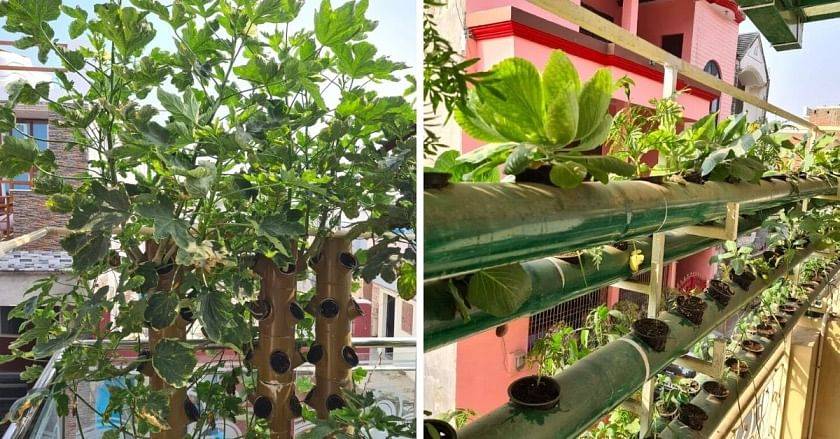
In 2009, Ramveer Singh of Bareilly, Uttar Pradesh, learnt that a friend's uncle had been diagnosed with cancer. Following additional investigation, he discovered that the reason for the life-threatening sickness was the chemical-laced vegetables.
"This worried me, and I decided to protect my family away from such dangers," he recalls.
Ramveer, a former full-time journalist, chose to leave his profession and devote his time to his ancestral property, where he grows organic vegetables. "The farm is 40 kilometres away from Bareilly, and I travelled to produce the vegetables and enhance the productivity on the land," he explains.
Ramveeer eventually began working as a freelance journalist and selling organic farm produce commercially on the side.
In 2017-18, he travelled to Dubai for an agricultural event and witnessed hydroponics farming. "I was intrigued by the agricultural process. It didn't require soil and could be cultivated with less pest infestation. Furthermore, it conserved about 80% of the water necessary for plant growth," he says.
For the following few weeks, Ramveer stayed and learnt farming techniques from the farmers. He decided to try out the farming approach at home once he returned.
Today, his enthusiasm and love for hydroponics has led him to turn his three-story house into a hydroponics farm that earns him lakhs of rupees.
10,000 plants in a house
Ramveer began installing hydroponics systems on his balcony and open spaces by utilizing pipes and other infrastructure.
"I employed Nutrient Film Technique (NFT) and Deep Flow Technique (DFT) to install two methods for the farm. At the moment, the farm covers 750 square metres and hosting over 10,000 plants," he added.
He cultivates okra, chillies, capsicum, bottle gourd, tomatoes, cauliflower, spinach, cabbage, strawberries, fenugreek, and green peas. "I use hydroponics to grow all of my seasonal vegetables. The system is made of PVC pipes and uses gravity to circulate the water. By introducing nutrients such as magnesium, copper, phosphorus, nitrogen, zinc, and others into the flowing water, the arrangement guarantees that they reach the plants. "The procedure saves 90% of the water," he says.
Ramveer feels that hydroponic farming is healthier and more effective than organic farming. "I believe that vegetables cultivated in hydroponics farming have greater nutritional uptake. Furthermore, there is no chance of soil contamination since a neighboring farmer using chemical farming may expose soil or plants by spraying chemicals or pesticides in conventional farming. "Hydroponic farming is free of dangerous chemicals," he claims.
Ramveer manages his farm, which is 40 kilometres from his residence, but he is no longer reliant on it. "I don't have to travel far to receive my weekly supply of vegetables.
I harvest it fresh from my farm and utilise it in the cooking," he says.
Passers-by were taken aback by his spectacular and one-of-a-kind farm, which was covered with vegetables that hung over the sides. "Many people enquired and demanded that the system be installed in their houses. I assisted at least ten people by establishing a hydroponic system for them," he continues.
The farmer founded the Vimpa Organic and Hydroponics enterprise, through which he earns more than Rs.60 lakh per year.
Ramveer's hydroponics system recently rescued a farmer's harvest from floods in Bihar.
"During the floods, the majority of farmers lost their harvest. However, I employed the hydroponics method to cultivate bitter gourd and was rescued by the floods since it was installed safely above ground," Sanjay explains.
He adds that when the market opened, the average selling price of the vegetable skyrocketed. "The average rate is Rs. 30-40 per kg." However, the scarcity drove up the price to Rs.80 per kg, which I benefitted from it," Sanjay says.
Ramveer is now content to produce soilless vegetables. "I am glad that my efforts and unique farming approach have assisted myself and many others in growing crops without the use of chemical pesticides," he says.
















